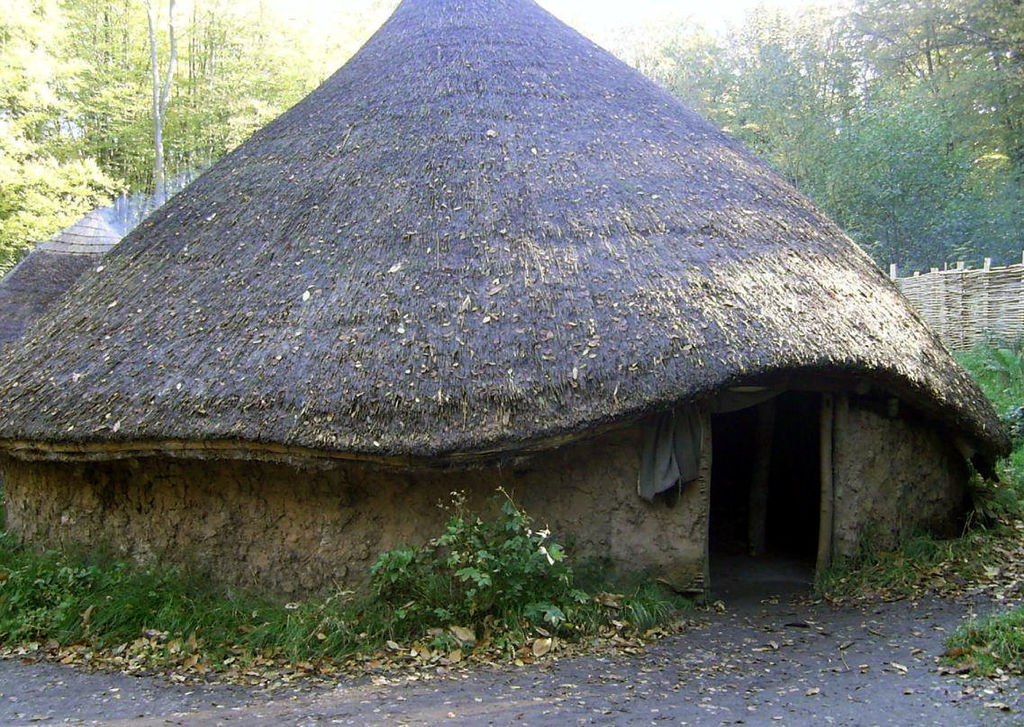Kevin and Fran Blockley brought the Stone Age to the Village Hall on the 19th September, in the form of pottery, tools, cured skins, and fabrics, which were grown, foraged and produced at Old Chapel Farm, Tylwch, home to the Out of Eden Stone Age Centre. Begun 4-5 years ago, this educational project uses experimental archaeology to track the development of the early hunter gatherers who came to Britain in the Mesolithic era, about 10,000 years ago, across the land bridge between Britain and continental Europe. These migrants originated in the Middle East, gradually spread westwards through Europe, and then crossed into Sussex where they established the earliest flint stone mines found in Britain.
The Neolithic era (4,500 to 6,000 years ago) saw big changes to the lives of hunter gatherers in the form of cultivation of the land and the development of pottery. Napped flint formed the basic tools for everyday life, for working skins and cutting, and for larger scale work as hafted pick and adze heads. Emmer, one of the earliest cultivated wheat strains, was grown, and domesticated cattle and sheep were brought from the European mainland. With the beginnings of agriculture came settlements. Evidence is slight for how these were formed, as post and stake holes provide the main clues, and what the settlement looked like above ground is mostly informed guesswork. Large hand axes were used for stone quarrying, and the discovery of Swiss tools from this period shows that there was an international trade operating. Buildings were made of oak posts, willow wattle, hazel for the roof and 30-35cms (12-14″) of heather thatch. The ridge was topped with turf, and walls were daubed with a mix of clay, straw and cow manure. Dwellings using these materials and Stone Age techniques have been built in the recreation of a small farmstead at Old Chapel Farm. The project draws in experts and volunteers, all ages and backgrounds, to experience aspects of the lives of our forebears, and to learns the skills on which their lives depended.
British wild cattle were domesticated in preference to the larger aurochs which were found across Europe and Asia as they were easier to handle. The sheep were similar to the horned mouflon, one of the ancestors of modern sheep, and were wool-less, so although animal skins were used for clothing, wool was not. At the Stone Age Centre there is a very small but growing flock of mouflon, and a small flock of soay, Britain’s most primitive sheep breed, originating in the western isles of Scotland. Yarn was instead made from nettle fibre and flax, and examples of these fibres were handed around for audience members to see and touch. Fran was wearing a tunic woven from these fibres and trousers made from buck skin, and the result was very stylish! Animal skins were used for outer wear and Kevin explained that ten roe deer skins were required to make a coat. These were sewn together using yarn made of nettle and flax fibres. Ropes of various weights were also made from these fibres. Another form of weaving was basketmaking using willow, and the same techniques were used for fish traps.
The tanning of animal skins was an important skill in Neolithic life. The project now has its own tannery, and experiments are being run to find the best methods of curing skins that could have been used. The farm’s woodland provides tannin and bark, and eggs and brain (for the fat content) soup are used, with the latter seeming the most effective. All these elements are organic and non-toxic, and no animals are killed to source the skins, although road casualties are used when available.
No evidence of Neolithic era kilns for pottery production has been found, but at the Stone Age Centre they have been experimenting with bonfire kilns, which so far have reached 700degsC. That is not hot enough to fire the clay effectively, but the trials continue in the hope of producing viable pottery. Pots would have been hand formed, using local clays, and these pre-dated wooden and leather vessels. Examples of pottery that originated in Europe and Asia have been found in archaeological excavations in Britain, indicating that there was significant movement of goods and people. Various examples of the handmade pottery were brought to the Girls’ Parlour for audience members to handle, as well as baskets, skins, fabrics, and tools of flint, stone, bone and horn. The questions and conversations prompted by this fascinating talk continued on over tea and coffee.
This very well attended event was three weeks after the successful project open days held on August Bank Holiday weekend at Old Chapel Farm. As well as opportunities for volunteers to get involved in this wonderful project, a range of courses and practical camps are held throughout the year. For more information about the Wilderness Trust and the Out of Eden Stone Age Centre, visit their website at http://thewildernesstrust.org/out-of-eden/.
